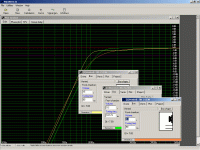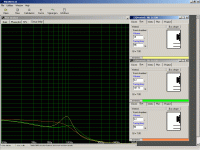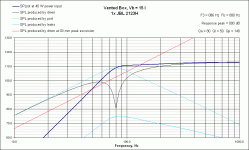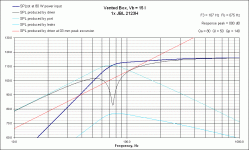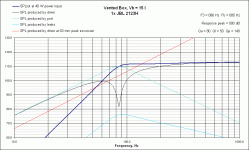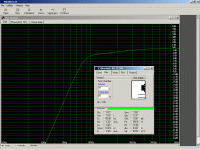mitchyz250f said:Midbass:
Will there be a difference in sound between the coreect 2" or 3" or 4" port? Is one louder or tighter or something? I will be using flared ports.
Mids:
Did you check out the 3" Peerless I am using. It has gotten pretty good reviews on DIYMobileaudio and works well in a small box. Very transparent. Sensitivity is a low 84.2. when you say tiny, are you talking about someting smaller than a 3"? [/B]
Unibox will show port air speed with a limit line for reference. A 2" dia port s/b plenty big for filtered midbass.
Yes, The peerless looks good/better but the price for 4 is over $100. It's relative to 7" mids I'm working with, but a 3" cone will always be tiny to me.
mitchyz250f said:After starting construction on cabinets, it looks like .32 - 35 cu/ft is going to be the actual size of the cabinets.
Isn't this cabinet volume getting small enough to minimize the usefulness of a ported system, and risk transient behavior in the desired bandwidth?
mitchyz250f said:Sadly I do not know how to post plots yet, maybe Monday. I having been using Winisd for a while, but after using Unibox,...
I like WinISD for quickly converging on an alignment, and then using Unibox for more detail and a cross check.
File image posting
On Unibox... each plot has a radio button for export .gif. Save xxx.gif at a known folder, and when posting using the dialog box, look below for attach file/browse button pointing it toward the folder and file.
Other things can be posted by using [cntl]+ [printscreen] and pasting in an image program like paint or photoshop.
tsmith1315 said:Isn't this cabinet volume getting small enough to minimize the usefulness of a ported system, and risk transient behavior in the desired bandwidth?
That's the whole problem in a nutshell, he's using a BR to get the box response wider than his xover filter. A sealed box is stuck with a narrower bandwidth compared to BR. As discussed, the transient will largely be determined by the xover filter he chooses. If it's a tuning problem inband, we'll see from Mitch's plots.
For backgnd re. sealed vs BR see the rest of this thread in loudspeaker board/forum.
infinia said:
he's using a BR to get the box response wider than his xover filter. A sealed box is stuck with a narrower bandwidth compared to BR.
Yeah, I got the gist. But mental math was predicting 0.33 cubic feet as being beyond the realm of porting for any reasonable use.
However, wisely using a calculator instead... It looks like he's still in fine shape.
For comparison, my knock-up formulas predict:
9.3 liter box
Fp of ~106Hz
F3 of ~117 Hz
Ripple ~ -.02dB
1.95" dia vent x 0.75" long
The vent length is a little sensitive to small diameters. Looks like 2.25"-3" diameters or so will afford easier tuning.
I'm curious as to how these match up to the programs' predictions.
15 liter 85Hz
WinISD shows -3dB down at 100Hz
box response slope =24dB/octave
midbass box combined with the 100Hz cross over it will be 8th order total. My concern is that sub and midbass will not add flat ...s/b dip due to asymetric 4th and 8th orders. Maybe Ok when EQ'd for cabin gain.
WinISD shows -3dB down at 100Hz
box response slope =24dB/octave
midbass box combined with the 100Hz cross over it will be 8th order total. My concern is that sub and midbass will not add flat ...s/b dip due to asymetric 4th and 8th orders. Maybe Ok when EQ'd for cabin gain.
Attachments
infinia said:check it out
Well, that corresponds close enough.
mitchyz250f said:It looks like I can make a 15L box fit if I fiberglass and use every spare inch (mm), it will be a lot more time consuming.
The below plots will work (I believe) with a 24 db Xover at 100 Hz.
Displacement-limited to 106dB @ 100Hz in 15L?
Would it be too much trouble to knock out the 9L in standard materials first for comparison?
Cabin Gain
Andy Wehmeyer, Global Product Line Manager, JBL Car Audio, Harman Consumer, posted a cabin chart on the DIY Mobile Audio site in May of this year. It is in this thread. Based on that I see an average of a 11 db gain on a 'typical' car. This varies wildly an some cars had no gain while other posted a 20 db gain.
http://www.diymobileaudio.com/forum/showthread.php?t=38784&highlight=cabin
Andy Wehmeyer, Global Product Line Manager, JBL Car Audio, Harman Consumer, posted a cabin chart on the DIY Mobile Audio site in May of this year. It is in this thread. Based on that I see an average of a 11 db gain on a 'typical' car. This varies wildly an some cars had no gain while other posted a 20 db gain.
http://www.diymobileaudio.com/forum/showthread.php?t=38784&highlight=cabin
OK, let me ask some questions from a project management point of view.
1) JBL 2123's and their smaller cousins the JBL 2118's were used successfully in several sound quality comp cars in either sealed or AP configuration. Most were crossed over 80 Hz. This would suggest that limited power was used as you would reach full cone excursion with the 2123's at 80 Hz with 50 watts at 102 db the 2118 are very similar. Does this mean the loudest the 2123's would play in this configuration is 102 db's?
2) How does the steep crossover effect between sub and MB affect audible performance? How does it affect transient? How does cabin gain effect a steep crossover?
3) As we understand my particular sub and midbass, how does change the crossover frequency effect midbass transients? Could a 125 Hz shallow slope crossover have better transients than a 100 with steeper slopes…? How well (fast, accurate) can we expect the sub to sound at 100 Hz or 125 Hz?
4) It seems that by changing the Fs of the MB we might solve some of the problems. Can I do this by adding weight to the cone?
In other words what is the next step?
TSmith - I could make a .9L box. But I would rather put the effort into just making the car version.
1) JBL 2123's and their smaller cousins the JBL 2118's were used successfully in several sound quality comp cars in either sealed or AP configuration. Most were crossed over 80 Hz. This would suggest that limited power was used as you would reach full cone excursion with the 2123's at 80 Hz with 50 watts at 102 db the 2118 are very similar. Does this mean the loudest the 2123's would play in this configuration is 102 db's?
2) How does the steep crossover effect between sub and MB affect audible performance? How does it affect transient? How does cabin gain effect a steep crossover?
3) As we understand my particular sub and midbass, how does change the crossover frequency effect midbass transients? Could a 125 Hz shallow slope crossover have better transients than a 100 with steeper slopes…? How well (fast, accurate) can we expect the sub to sound at 100 Hz or 125 Hz?
4) It seems that by changing the Fs of the MB we might solve some of the problems. Can I do this by adding weight to the cone?
In other words what is the next step?
TSmith - I could make a .9L box. But I would rather put the effort into just making the car version.
mitchyz250f said:OK, let me ask some questions from a project management point of view.
snip>
In other words what is the next step?
1) I don't know much about sound quality comp cars. Maybe they used extensive EQ on sealed boxes. does SPL rule over THD in judges weighting? Try to find out more info on what box they used and EQ. I can't help here, sorry.
2&3) I was mainly concerned about -3dB gradual drop with MBass response as well as the asymentrical filter summing to a minor degree. In my mind the steeper slopes help minimize summing mismatch. Transient response is a lesser order effect compared to other stuff going on system wise here. To EQ flat, taking account of cabin gain you want a gradual rolloff of the sub SPL compared to midbass. So this begs the Question... does car cabin gain help your Mbass droop?
4) Just build it.... 12-15 liter tuned to 90Hz? Use the 100 Hz 4th order crossover. You could always add cone mass, reduce box volume, and change/plug ports later.
1) Others can correct me I amnot not knowledgable in this area.
Application for the JBL 2123 and 2118. One car used and AP membrane (Toyota Forerunner), other IB (Prelude)and another a sealed .5 box. I think this shows the general application.
There may be a minum SPL for sound quality car but for the most part it has to do with:
o Tonal Accuracy and Spectral Balance
o Soundstage and Ambiance
o Imaging
o Sound Linearity
o Ergonomics
o Noise Adjustment
* Frequency Response - RTAv
Extensive use of EQ and TA is pretty standard.
2) & 3) Build it now fine tune later.
4) Yep.
Application for the JBL 2123 and 2118. One car used and AP membrane (Toyota Forerunner), other IB (Prelude)and another a sealed .5 box. I think this shows the general application.
There may be a minum SPL for sound quality car but for the most part it has to do with:
o Tonal Accuracy and Spectral Balance
o Soundstage and Ambiance
o Imaging
o Sound Linearity
o Ergonomics
o Noise Adjustment
* Frequency Response - RTAv
Extensive use of EQ and TA is pretty standard.
2) & 3) Build it now fine tune later.
4) Yep.
mitchyz250f said:
There may be a minum SPL for sound quality car but for the most part it has to do with:
o Tonal Accuracy and Spectral Balance
o Soundstage and Ambiance
o Imaging
o Sound Linearity
o Ergonomics
o Noise Adjustment
* Frequency Response - RTAv
Extensive use of EQ and TA is pretty standard.
Back in the day, SPL in the SQ counted up to 130dB. Anything beyond wasn't helpful. IIRC, you got a point per dB over 100dB with a max of 30 points. I hope that's right, this old memory is fuzzy.
RTA judge looked for smoothness on 1/3 octave analyzer. IIRC, full points here required no change >3dB between plot points. The Audio Control RTA's LED display was in 3dB increments, so it was easy to gauge points if you were close to a perfect score.
Obviously, it was advantageous to use a 1/3 octave EQ with frequencies corresponding to the RTA's.
There was no provision for THD or phase measurement.
As far as the SQ judging went, it was mostly subjective. Only competed a couple of times locally in '84/'85. I quit attending big shows as a spectator later because appearance seemed to seriously affect the judges idea of SQ. Too annoying to even watch.
The last car I tuned for comp was done in '91 or'92 with the standard Audio Control RTA. Mic was placed per IASCA rules, and after about 30 min, we got several consecutive plots that would have been a perfect score (still have the plots somewhere.)
Competition was IASCA sanctioned, run by a mass retailer at their location the next day. He scored a 6 out of... I think it was 30 possible points on RTA. We still chuckle over that every few years.
I can help with a few of these.
1) The crossover chips are inline DIP resistor networks. You can get these at any respectable electronics supplier. It can be thought of as a molded, encased version of a 14 machine pin socket with a resistor of the same value going from pin 1 to pin 14, pin 2 to 13, etc.
+ + + + + + +
| | | | | | |
+ + + + + + +
(crude ascii example, lines are resistors of all same value)
You would fab one by using a machine pin type 14 pin socket, get your 7 resistors and cut the leads down to about 1/4", bend them and insert them into each set of socket pins. You can solder them in or leave them as-is. Then plug the module into the socket on the AC.
To buy them, just find the value you want and look for 14 pin DIP resistor networks. If you have trouble with your search methods, call mouser and just explain it to them.
2) I prefer my ports on the same side and facing the same direction of the driver.
3) For midbass duties, I would try and find an aeroport that suits your needs, or attempt to fabricate one. Very low port noise on these designs. here for examples -> http://www.subwoofer-builder.com/flares-commercial.htm
Think thats my .02 for the day.
- Matt
1) The crossover chips are inline DIP resistor networks. You can get these at any respectable electronics supplier. It can be thought of as a molded, encased version of a 14 machine pin socket with a resistor of the same value going from pin 1 to pin 14, pin 2 to 13, etc.
+ + + + + + +
| | | | | | |
+ + + + + + +
(crude ascii example, lines are resistors of all same value)
You would fab one by using a machine pin type 14 pin socket, get your 7 resistors and cut the leads down to about 1/4", bend them and insert them into each set of socket pins. You can solder them in or leave them as-is. Then plug the module into the socket on the AC.
To buy them, just find the value you want and look for 14 pin DIP resistor networks. If you have trouble with your search methods, call mouser and just explain it to them.
2) I prefer my ports on the same side and facing the same direction of the driver.
3) For midbass duties, I would try and find an aeroport that suits your needs, or attempt to fabricate one. Very low port noise on these designs. here for examples -> http://www.subwoofer-builder.com/flares-commercial.htm
Think thats my .02 for the day.
- Matt
- Status
- This old topic is closed. If you want to reopen this topic, contact a moderator using the "Report Post" button.
- Home
- General Interest
- Car Audio
- Porting a JBL 2123 for midbass duties
